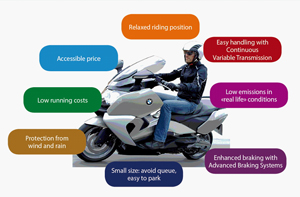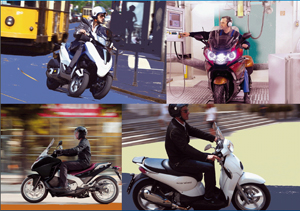Powered Two-Wheelers is Smart Choice for Urban Mobility: ACEM
PTWs emit 50% less CO2 than automobiles over the same distance
2013/04/01 | By Quincy Liang
The ACEM, a professional body representing the interests of 13 PTW manufacturers producing more than 30 brands, and 15 national associations out of 13 European countries, says European cities are main engines of economic growth, but today's urbanization trends are generating increased congestion, greenhouse gases, air pollution, noise, waste of energy and avoidable associated costs. Quality of life and prosperity in European cities rely on efficient and sustainable mobility while economic and individual development of citizens depend also on affordable and adaptable transport options, ACEM says.
Innovative mobility should also be about creating a new culture of offering more transport options. Administrations, striving to find solutions compatible with stricter than ever budgetary constraints, should learn to exploit the advantages offered by PTWs in terms of making traffic more fluid and requiring less parking space, while citizens could benefit from their flexibility, convenience and affordability, says ACEM.
Outlook for Mobility in EU
The European Commission adopted a roadmap for the next decade to build a competitive transport system that will increase mobility, remove major barriers in key areas and fuel growth and employment. The objective of these proposals is to dramatically reduce Europe's dependence on imported oil and cut carbon emissions in transport by 60% by 2050. One of the key goals is no more conventionally-fuelled cars in cities.
The European Commission has called for a "necessary transition from a primarily car- based personal mobility in cities to walking and cycling, high quality public transport and less-used and cleaner passenger vehicles as the central strategic challenge for cities in the decades to come." The commission's White Paper on Transport, according to ACEM, argues that clean urban transport and commuting can be achieved also by using smaller, lighter and more specialized passenger vehicles.
As urban populations in Europe are estimated to grow from today's 60% to 80% by 2020, ACEM says an efficient, integrated urban transport toolbox should support and encourage the development on an equal footing of different private and public transport modes, addressing citizens' needs.

Increasingly Popular PTWs
Today's lifestyle calls for flexible individual mobility. Door-to-door trips and multi-destination journeys are essential components of a modern way of life. Only personal powered transport allows this kind of flexibility, ACEM stresses. One widely used form of transport, chosen by an increasing number of users, is the PTW. The staggering growth of PTWs in cities in recent years proves that citizens are more and more finding motorcycles and scooters the solution for daily mobility needs.
PTWs, especially scooters in cities, feature many advantages unmatched by cars or other transportation, ACEM says, including relaxed riding position, easy handling with continuous variable transmission (CVT), low emissions, enhanced braking with advanced braking systems, small size (avoid traffic jams, easy to park etc.), low running costs, accessible price etc.
The association also lists three major reasons for choosing PTWs as urban transportation. First, PTWs cover a wide range from mopeds (PTWs with engine displacements under 50cc), scooters and other small capacity motorcycles, ideal for urban journeys, to large capacity custom, sports and touring models. Second, these vehicles, since the early 1980s, have experienced tremendous technical and design improvements. PTW manufacturers have developed and marketed safer, cheaper, more economical to run and more comfortable products. Third, tricycles, minicars, light commercial quadricycles are also part of the PTW family.
The PTW industry has still many other influences today, according to ACEM, including:
• Motorcycling is popular: in the EU around 35 million users ride regularly.
• Riders contribute around 150 billion euro per annum to the EU economy.
• Biking is big business: The motorcycle industry employs 150,000 people in 5,700 enterprises. 2,000,000 new bikes are sold each year (2010) in the EU.
• Motorcycles bring mobility: Citizens take to PTW when and where traffic congestion and incomplete public transport make for inconvenient mobility.
• Motorcycling responds to practical needs: Over 60% of journeys are for commuting, utility, practical purposes (especially important for job seekers and for those on low incomes).
• PTWs save time: Cutting journey times by up to 48% in some surveys.
• PTWs use land more efficiently: Up to 5 bikes can fit into one car parking space.
• Riders reduce traffic congestion: Motorcycles and scooters are shorter and narrower and remain more mobile in traffic jams.
• PTWs create very little pollution: In real life conditions, for the same journey, PTWs emit 50% less CO2 than automobiles.
• On average risk of injury has fallen by 18% in the EU since 2001.
PTWs & Environment
Unlike before two-stroke engine PTWs are rare and governments' stringent emission standards and PTW makers' vigorous efforts in engine technologies make current PTWs very clean transportation featuring low emission relative to cars.
ACEM says manufacturers' commitment towards the environment and their innovative capacity ensures that emissions from all L-category vehicles (scooters, motorcycles, quadricycles, etc.) are continuously reduced, which are regulated at European level. Compared to other road-surface transports (automobiles, freight transport etc.), PTWs today contribute to only 2% of overall emissions, according to the association's statistics.
In addition, ACEM stresses, motorcycles require far fewer resources during manufacturing. Once a motorcycle has reached the end of its useful life, over 75% of components can be reused on other machines, the remaining 25% can be recycled. That fits the 3R (reduce, reuse and recycle) concept very well.

Electric Mobility
Electric scooters combining low costs with eco-friendly mobility are becoming more popular, ACEM says. Electric PTWs are light, small and specifically intended for urban use. Despite the great potential represented by electric vehicles (EVs) and fuelled by extensive media coverage, "range anxiety" and costs still prevent extensive popularization.
Electric PTWs still account for only 0.3% of the market, although they experienced a 60% surge in purchases between 2009 and 2010, and a similar growth in 2011, ACEM says. Electric cars will always be bound by size and mass, however, the association adds, so PTWs are best positioned to fully explore the advantages of electric mobility in cities, which is based on limited ranges, shortage of parking spaces and trips through highly congested areas. PTWs are the most viable transport to fully shift to electro-mobility provided they are supported by public policies.
Conclusion
PTWs over short distances are a great solution, especially when intended as part of a 'multimodal' journey, in daily urban travel, ACEM concludes. 'Joining up' travel for longer journeys, meaning that PTWs can be used at the beginning and/or end of journeys where public transport cannot offer a complete door-to-door solution, will require PTW facilities at public transport intersections.
In its comprehensive strategy to a single European transport system, ACEM says, the European Commission encourages "the use of smaller, lighter and more specialized road passenger vehicles" leading to a "substantial contribution in reducing the carbon intensity of urban transport while providing a test bed for new technologies and opportunity for early market deployment".
Mopeds, scooters, motorcycles, tricycles and quadricycles are all options in a truly multi-modal approach to mobility. "Smart individual mobility can contribute to change our transport paradigm through innovation; quality of life depends on our capacity to innovate mobility," the European PTW maker association reiterates.




